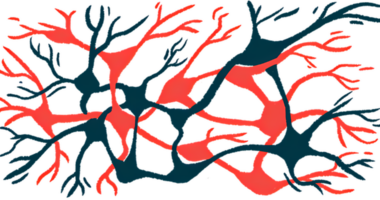Cell, mouse models of Parkinson’s disease give data on GT-02287
Developer shares positive results on therapy now being tested in humans

By activating an enzyme known as beta-glucocerebrosidase, or GCase, the experimental therapy GT-02287 is able to improve nerve survival and reduce the dysfunction of lysosomes — structures that work like cellular garbage disposal systems and clear away molecular debris — in cell models of Parkinson’s disease.
The Gain Therapeutics treatment candidate also improved motor function and reduced signs of nerve damage in a Parkinson’s mouse model.
“These data further confirm our understanding of the mechanism of action of GT-02287, how it impacts cellular health by preventing the downstream consequences of GCase misfolding, including cellular stress and lysosomal dysfunction,” Natàlia Pérez-Carmona, PhD, senior director of biology at Gain, said in a company press release.
GT-02287 is an orally available treatment that’s now being tested for safety in healthy volunteers in a Phase 1 clinical trial in Australia. That trial also is assessing the pharmacological properties of the therapy, Gain’s lead candidate, which was developed with the company’s proprietary platform SEE-Tx,.
During the International Conference on Alzheimer’s and Parkinson’s Diseases and Related Neurological Disorders (AD/PD 2024), taking place this week in Portugal, Pérez-Carmona presented data highlighting the therapy’s efficacy in preclinical work, namely in cell and mouse models of Parkinson’s disease. The poster was titled “GT-02287, a clinical stage GCase enhancer, displays neuroprotection and restores motor function in preclinical models of Parkinson’s disease following delayed administration.”
GT-02287 shows benefits in cell, mouse models of Parkinson’s disease
Lysosomes are cellular structures that are sometimes called the garbage disposals or recycling plants of the cell, as they are responsible for chopping up large molecules into small pieces that can be reused. GCase is one of the enzymes that lysosomes use to break up molecular trash.
Mutations in the GBA1 gene that encodes the GCase enzyme are one of the most common genetic causes of Parkinson’s. When lysosomes aren’t working correctly, waste molecules can build up to toxic levels in cells, and this may contribute to the death and degeneration of nerve cells that occurs in the neurodegenerative disease.
Lysosome dysfunction is also thought to play a major role in non-genetic forms of Parkinson’s disease, given that most cases are marked by toxic clumps of proteins, especially alpha-synuclein, in nerve cells.
GT-02287 is designed to boost lysosomal activity by activating the GCase enzyme.
At the conference in Lisbon, Pérez-Carmona showcased the therapy’s effectiveness as seen in both cell and mouse models of Parkinson’s disease.
“The AD/PD conference is an important opportunity for us to continue to discuss our differentiated approach to addressing GBA1 Parkinson’s disease through GCase modulation among this key audience,” Pérez-Carmona said.
These new data support the potential of GT-02287 as a disease-modifying therapy for Parkinson’s disease.
In a first series of experiments, GT-02287 was tested in rats’ dopaminergic neurons — the main nerve cells affected in Parkinson’s — that were exposed to toxic alpha-synuclein clumps and a drug that decreases GCase activity. The results demonstrated that GT-02287 treatment increased cell survival and improved lysosomal functioning. GT-02287-treated nerve cells also were better able to connect to each other to form the neural networks needed for brain signaling.
“These new data support the potential of GT-02287 as a disease-modifying therapy for Parkinson’s disease,” the researchers wrote in the poster presentation.
The next set of experiments used a mouse model in which Parkinson’s-like motor symptoms were induced by injecting the mice with alpha-synuclein clumps and the GCase-blocking drug. To measure motor dysfunction, the researchers conducted an examination called the wire hang test, which simply measures how long the mice are able to hold on when dangled from a wire.
Healthy mice were able to hang for nearly five minutes, on average, whereas untreated mice given the Parkinson’s-mimicking chemicals weren’t able to hold on for one minute. However, when the Parkinson’s mice were treated with GT-02287, their hang times were comparable to those of the healthy mice.
The Parkinson’s mice also had elevated levels of a nerve damage marker called neurofilament light chain (NfL), but treatment with GT-02287 reduced NfL to near-normal levels.
“NfL, an emerging biomarker of neurodegeneration, was reduced to control levels, reflecting the motor deficit rescue observed in the wire hang test,” the researchers concluded.
The AD/PD Conference is an annual event held to focus on developments in research and treatments for Parkinson’s, Alzheimer’s disease, and other related disorders.







